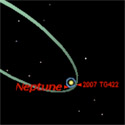The Killer Asteroid Research Project
by Kathleen McCoy |
UAA is currently piloting the "Killer Asteroids Project" in one of the core lab science courses in UAA's Bachelor of Liberal Studies program and also an introductory astronomy lab course. Over the past few years, Dr. Andy Puckett has been working with undergraduate students in introductory science courses to improve the orbits of asteroids. They make observations of asteroids with poorly-known orbits and then submit those observations to the Minor Planet Center at Harvard. So far, 103 students have submitted 225 positions of 23 asteroids, and those submissions are published with the students listed as co-authors. Once the new observations have been made, the students also have to quantify how much they've improved the orbit, in terms of the amount of uncertainty that remains in the orbit.
 This project is part of the Research-Based Science Education for Undergraduates (RBSEU)
group at UAA that develops and studies the effectiveness of research-based science
education (RBSE) curricula in astronomy for entry-level undergraduate courses. RBSE
is a method of instruction that models the processes of scientific inquiry and exploration
used by scientists to discover new knowledge. It is "research-based" in the sense
that students work together on a real astronomical research project. In other words,
in order to learn science, students are given the opportunity to actually do science.
The work is funded through a Course, Curriculum and Laboratory Improvement grant from
the National Science Foundation. This new curriculum will ultimately be helpful to
instructors at other institutions, in astronomy and other fields.
This project is part of the Research-Based Science Education for Undergraduates (RBSEU)
group at UAA that develops and studies the effectiveness of research-based science
education (RBSE) curricula in astronomy for entry-level undergraduate courses. RBSE
is a method of instruction that models the processes of scientific inquiry and exploration
used by scientists to discover new knowledge. It is "research-based" in the sense
that students work together on a real astronomical research project. In other words,
in order to learn science, students are given the opportunity to actually do science.
The work is funded through a Course, Curriculum and Laboratory Improvement grant from
the National Science Foundation. This new curriculum will ultimately be helpful to
instructors at other institutions, in astronomy and other fields.
One of Puckett and his students' most recent success stories has been 2007 TG422, which has one of the most eccentric orbits of any non-cometary object in the outer Solar System. Originally, the orbit's farthest point from the Sun was known only to be in the extremely broad range of 900 -- 5,000 AU. The students' measurements have reduced this uncertainty to 1,000 -- 1,040 AU, based rather remarkably on only two years of observations of its 12,000-year orbit. AU, or astronomical unit, is a unit of length equal to about 92,955,807 miles. It is defined as the mean distance between the Earth and the Sun over one Earth orbit.
 "The Killer Asteroid Research Project" is licensed under a Creative Commons Attribution-NonCommercial 4.0 International License.
"The Killer Asteroid Research Project" is licensed under a Creative Commons Attribution-NonCommercial 4.0 International License.









